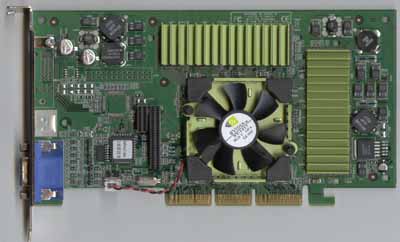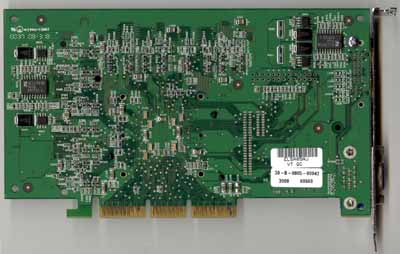
Original Link: https://www.anandtech.com/show/634
ELSA GLADIAC ULTRA 64MB GeForce2 Ultra
by Anand Lal Shimpi on October 12, 2000 2:47 AM EST- Posted in
- GPUs
 Just
two months ago, NVIDIA gave us two special presents, the introduction of the
Detonator3 drivers as well as the debut of
what was and continues to be the fastest desktop 3D graphics accelerator, the
GeForce2 Ultra.
Just
two months ago, NVIDIA gave us two special presents, the introduction of the
Detonator3 drivers as well as the debut of
what was and continues to be the fastest desktop 3D graphics accelerator, the
GeForce2 Ultra.
While we embraced the release of the Detonator3 drivers that increased performance of all GeForce based cards by a noticeable amount, the release of the GeForce2 Ultra caught us off guard. When combined with the Detonator3 drivers, the GeForce2 GTS that had been released just four months earlier regained its dominance over the competition. If you recall, the ATI Radeon, immediately upon its arrival on the scene proceeded to give NVIDIA a serious run for their money as the card, in many cases, bested a GeForce2 GTS or provided performance very close to it.
The Detonator3 drivers did put the GeForce2 GTS back in the lead, however feeling the pressure of the Radeon as well as the potential trouble they could get into if 3dfx were to release a Voodoo5 6000, NVIDIA decided to go ahead with the GeForce2 Ultra release.
This left us somewhat disappointed, as we were expecting to see the elusive ‘NV20’ instead of the Ultra, and with the release of the Ultra we began to question if we would actually see the NV20 before next year. The answer to that question is still quite vague, as NVIDIA told us back in August that the NV20 could be released between 4 and 8 months from the introduction of the Ultra, placing the NV20’s launch anywhere from December 2000 to April 2001.
Regardless, there are many individuals that aren’t willing to wait for the NV20 and want the fastest available today. While the percentage of the hardware enthusiast population that has the ability and/or the desire to spend half of their hardware budget on a video card, there is a small but tangible demand for such a product. And where there is consumer demand, there are companies that will meet those demands.
We originally expected to see the first GeForce2 Ultra based cards emerge from Creative Labs, as they had an “exclusive” agreement with NVIDIA to produce and sell the cards before most of the other manufacturers. However, as you can probably tell by the title of this review, that’s not the way the situation ended up unfolding. Promising to have their Ultra based cards on store shelves before the end of the month, ELSA may continue their recent tradition of being first out the door with cards based on NVIDIA’s latest solution. If you remember, the GLADIAC was the first available GeForce2 GTS based graphics card, and now the GLADIAC ULTRA may end up being the first available GeForce2 Ultra based solution on the market.
For features of the GeForce2 Ultra visit our GeForce2 Ultra Review.
The Card
Just as with the GeForce2 GTS based GLADIAC, ELSA didn’t stray far from NVIDIA’s reference design with their GLADIAC ULTRA. Unlike in the early days of graphics cards, reference designs are now the way to go for manufacturers like ELSA, since they are designed very well and are extremely easy to implement. In contrast, just a few years ago, the same could definitely not be said about the kings of the graphics industry back then and their reference designs.
Needless to say, by adhering to NVIDIA’s reference design, ELSA not only cuts down on development time for the card, but they can also put it on shelves much quicker than they would be able to if they had come up with their own design. This is obviously a sacrifice they make as the reference design has no room for added features such as the multitude of video input and output ports we see on ASUS’ Deluxe series of GeForce and GeForce2 GTS based cards. ELSA does take a unique approach to tackling this tradeoff, which we will discuss later on.
As with all Ultra based boards, the GLADIAC ULTRA features the 0.18-micron GeForce2 Ultra core which runs at 250MHz. As we concluded in our review of the GeForce2 Ultra, these Ultra chips are essentially hand picked GeForce2 GTS cores that happen to hit the higher clock speed specified by NVIDIA, much like how the TNT2 Ultra chips were distinguished from the regular TNT2 chips during their reign.
ELSA GLADIAC
ULTRA
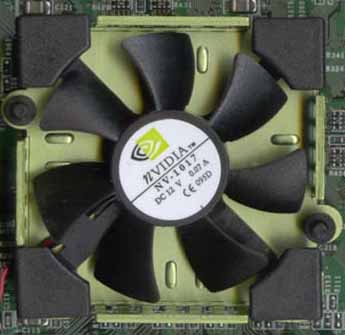
GeForce2
Ultra Reference Design
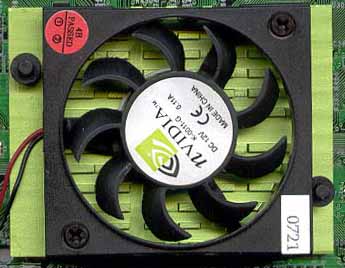
In cooling this high clocked core, ELSA implemented an even larger heatsink/fan combo than what we saw on the reference Ultra board we received from NVIDIA in August. The heatsink measures 2” x 2” (5.08 cm x 5.08 cm), while the reference design heatsink was approximately 2.25” x 1.75”. The resulting surface area of the heatsink on the GLADIAC ULTRA is about 2% larger than what was present on the reference board, but that alone shouldn’t provide for a dramatic increase in cooling efficiency.
However, ELSA has also implemented a larger fan to go along with this larger heatsink. Instead of the 10 finned fan that spanned a diameter of 1.5” as we noticed on the reference board, ELSA implemented a fan with 7 larger fins and a full 2” diameter to aid in cooling the Ultra’s core. The two fans appear to spin at the same rate, meaning that ELSA’s fan should be effectively a better cooler than what we saw on the reference boards.
ELSA implements the same two heatsinks that we saw on the reference board across its 8 ESMT SDRAM chips. These SDRAM chips are rated at 4ns, giving them a theoretical maximum operating frequency of 250MHz DDR (effectively 500MHz). With the GLADIAC ULTRA, as well as all other Ultra based boards, shipping with a 460MHz effective memory clock, this opens up quite an avenue for overclockers to experiment with. NVIDIA’s reason for specifying a 460MHz memory clock while using 500MHz SDRAM is simple, the yields on these 4ns parts aren’t high enough to allow for them to successfully operate at 500MHz on an Ultra board 100% of the time. Thus by rating the GeForce2 Ultra’s memory clock at 460MHz NVIDIA is essentially playing it safe, however for those that don’t mind playing in the realm of overclocked frequencies, the chances of hitting 500MHz are pretty good.
Unlike the ‘RAMsinks’ we saw on Guillemot’s (Hercules) 3D Prophet II GTS which didn’t really do much at all, the heatsinks on the GLADIAC ULTRA actually do help cool those extremely hot running memory chips. As we found in our GeForce2 Ultra review, removing just one of the two heatsinks compromised stability.
Feature-wise, the GLADIAC ULTRA is essentially a completely stripped version of the NVIDIA GeForce2 Ultra reference card we saw back in August. The board was shipped to us with no TV-out header and no DVI port. While we didn’t expect to see a DVI output connector on the GLADIAC ULTRA since there is still a relatively low installed user base of DVI flat panel monitors, what was truly interesting was the fact that there wasn’t even a cutout for an add-in TV-out module on the card. This is evidence that ELSA probably had one thing in mind with the production of the GLADIAC ULTRA, and that being “get it ready and shipped as soon as possible.” Without a cutout for the S-Video port on the expansion slot bracket on the card, the only hope for ever having video out support on the GLADIAC ULTRA is if you replace the expansion slot bracket on the card itself.
This brings up the next point of concern, ELSA’s VIVO module. Just as with the GLADIAC, ELSA is promising the availability of their VIVO (Video-In/Video-Out) add-in module for the GLADIAC ULTRA. This module essentially looks like the TV-out header that is present on the NVIDIA reference design however it features a Phillips controller chip instead of the Brooktree BT869 chip that can only do TV-out. This custom chip will allow users to switch between using the single S-Video port as a TV-input or output port, most likely through an interface in ELSA’s drivers.

No S-Video cutout on the
GLADIAC Ultra

The reference board features
S-Video and DVI ports
This unfortunately poses a number of problems. For starters, as we just finished mentioning, there is no space for a S-Video port on the expansion slot bracket, meaning that ELSA will have to package a modified bracket as well as instructions on how to remove the current one if they plan on releasing the VIVO module. Another way around this is for ELSA to simply start shipping boards with a pre-modified bracket, however this will leave early adopters in the dark as they will still be left with a bracket with no S-Video cutouts.
Secondly, with only a single S-Video port, the GLADIAC ULTRA loses quite a bit of functionality. While on an ASUS Deluxe card you are able to have an input device such as a VCR or Camcorder always hooked up as well as a TV connected for video output, the ELSA VIVO module will force you to use one function or the other (video in or video out) and not both simultaneously. There is another possibility here, that ELSA will adopt some sort of dongle that will attach to the single port on the VIVO module thus allowing simultaneous video input and output. It is hard to say for sure what will eventually happen as the VIVO module is still not available, even though it was something that was originally talked about when the GLADIAC was released.
One benefit of this however is that for those users that don’t really care about TV input or output functions, the added cost of the daughterboard is removed from the total price of the GLADIAC ULTRA and for those that really want it, provided that the module actually does hit the streets, an extra $40 will buy you the port.
Concluding the features of the GLADIAC ULTRA is the bundled 3D Revelator glasses. The 3D Revelator glasses which should work on all TNT, TNT2, GeForce and GeForce2 based cards including the GLADIAC ULTRA enable the simulation of a truly three dimensional environment while playing any Direct3D games.

This is accomplished by essentially fooling the human eye into seeing depth. We explained this process in our ASUS V6800 Deluxe Review:
[Fooling your eyes into seeing depth] is accomplished by rendering alternating frames in a game during each refresh cycle of the monitor. The glasses work in conjunction with this technology in order to match each frame to a separate eye. This is done using a polarizing effect. When electricity is passed through a thin layer of a semitransparent polarized substance that is sandwiched between two pieces of glass, the polarized part becomes darker. This lightening and darkening of the glass occurs in synchronization with the monitor refresh to allow only one eye to see each frame. For example, frame 1 is rendered for the left eye a bit to the left side of the screen and viewed through the transparent left lens. Then, the second frame in the game placed on the right side of the screen while the left lens of the glasses go dark. This works in the same way that normal depth perception is formed, as your eyes (which are set apart) do this naturally. To the onlooker without glasses, the game in question looks like two pictures overlapped on one another. To the person viewing through the glasses, the effect is 3D: looking almost like images and text are jumping out at you.
The 3D Revelator glasses differ noticeably from the VR glasses bundled with the ASUS V6800 and V7700 Deluxe cards. For starters, the glasses only support Direct3D games. Secondly, instead of connecting to the card via an 1/8” jack, the 3D Revelator glasses packaged with the GLADIAC ULTRA rely on a wireless infrared interface in order to communicate with the card.
The way this works is simple, ELSA bundles a Y-splitter cable with the GLADIAC ULTRA. This splits the 15-pin female VGA connector on the card into two connectors, another 15-pin female VGA connector for your monitor as well as a custom 3-pin connector for an IR transmitter. This IR transmitter has 6’ of wire between the actual transmitter and its 3-pin interface that connects to the Y-splitter so you can mount the transmitter closer to your monitor, where your head would normally be oriented towards while playing a game.
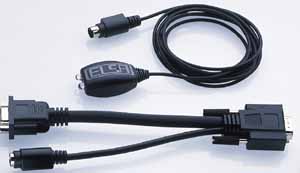
The 3D Revelator glasses have an IR receiver that communicates with this transmitter, and thus allows for the 3D effect to be created without any cables tying you to your computer, allowing a bit more freedom of movement and removing some wire clutter. The cordless glasses also conveniently shut off when you fold the right earpiece, something ASUS’ bundled glasses don’t do at all. Powering the glasses are two batteries that are stored in the nosepiece and ELSA also provides a smooth cloth case for the glasses than can also double as a cleaning tool.
On the software end, setting up the 3D Revelator glasses is fairly simple. For starters, you must use ELSA’s drivers, meaning you give up the benefit of always having the latest release drivers on your system. You have to wait until ELSA releases a driver update. Then, you must also have a monitor capable of displaying a resolution at somewhere between a 100Hz and a 140Hz refresh rate, this is to allow for the 3D effect to be simulated. After setting up your monitor to display at a refresh rate within the aforementioned range, you can enable the Stereo display option and you should be on your way.
Unfortunately there are some limitations. As we briefly mentioned before, this only works with Direct3D games. To take that limited support even further, not all Direct3D games will work with the setup either. The glasses may also cause headaches for some users because of the intense flickering caused by the alternate frame display.
For the most part, the glasses don’t, at least in our opinion, add much value to the GLADIAC ULTRA package, however some may get a little kick out of using them.
Overclocking
When we first reviewed the GeForce2 Ultra we managed to get it to run at a 285MHz core clock and a 500MHz memory clock. At the combination of those two speeds it passed our overclocking tests flawlessly, for more information on how to properly test a video card's stability when overclocked read our quick one page Guide to Overclocking a Video Card.
We didn't expect the memory on the GLADIAC ULTRA to go much higher than its rated 500MHz level (250MHz DDR), simply because the yields on those 4ns SDRAM chips aren't nearly as high as they would need to be in order for 500MHz+ overclocks to be made possible. The GLADIAC ULTRA should shine in terms of its maximum core overclock since it is using a heatsink/fan combo that not only has a greater surface area (heatsink) but also more powerful cooling capabilities (larger fan) than the reference board we tested back in August.
Testing the memory revealed that our predictions were correct, the GLADIAC ULTRA wouldn't budge above 500MHz. However the core was good up to 310MHz, just 5MHz shy of the limit of NVIDIA's 'CoolBits' overclocking slider. Of course a lot of this is dependent on the luck of the draw when it comes to yield on the individual GeForce2 Ultra chips, however at least some of the GLADIAC ULTRA's core overclocking success can be attributed to the slightly larger heatsink and more powerful fan.
Unfortunately, as we've discovered time and time again, the benefits we get from overclocking the core of the GeForce2 aren't nearly as great as those attained by increasing the memory clock. Making the ability to hit 310MHz on the GLADIAC ULTRA not that impressive of a feat, as if the Ultra weren't fast enough already.
Chances are that you won't see any GeForce2 Ultra based cards that have extremely overclockable memory this soon, as the yields on the 4ns chips aren't high enough for that to happen. It will over time, as yields improve, but for now just be glad that you can hit 500MHz in some of these cases.
Drivers
ELSA's drivers are pretty much what we've come to expect from a video card manufacturer, nothing too special exists here. What was somewhat impressive was that ELSA did include Linux drivers on their bundled driver CD, however they were the old Detonator2 based 0.9-4 drivers instead of the new Detonator3 based 0.9-5 drivers. Even the Windows 9x/2000 drivers that were bundled with the card were using an older Detonator2 base instead of the latest Detonator3 drivers, this is the unfortunate problem when dealing with manufacturer supplied drivers.

ELSA's taskbar utility is much like other similar utilities by competing manufacturers

A disable VSync feature is available by default, something that isn't present
under the Direct3D tab by default in the latest reference drivers.

The ELSA drivers provide for the adjustment of FSAA options however because
they aren't based on the newer Detonator3 drivers the utility fails to identify
what setting each tic mark corresponds to.

Because ELSA doesn't use the latest Detonator3 drivers, under OpenGL properties,
only a single FSAA setting is available (2x2).



Here we see some of the limited application settings available for use by default
with the 3D Revelator glasses.


The Test
|
Windows 98 SE Test System |
|||||||
|
Hardware |
|||||||
| CPU(s) | AMD Athlon (K75) 750 | ||||||
| Motherboard(s) | ASUS K7V-RM | ||||||
| Memory | 128MB PC133 Corsair SDRAM (Micron -7E Chips) | ||||||
| Hard Drive |
IBM Deskstar DPTA-372050 20.5GB 7200 RPM Ultra ATA 66 |
||||||
| CDROM |
Phillips 48X |
||||||
| Video Card(s) |
ELSA
GLADIAC ULTRA 64MB DDR clocked at 250/230 DDR ATI
Radeon 64MB DDR |
||||||
| Ethernet |
Linksys LNE100TX 100Mbit PCI Ethernet Adapter |
||||||
|
Software |
|||||||
|
Operating System |
Windows 98 SE |
||||||
| Video Drivers |
|
||||||
|
Benchmarking Applications |
|||||||
| Gaming |
idSoftware
Quake III Arena demo001.dm3 |
||||||

At 640 x 480 x 32 there are two main video card related factors that are altering performance. Those factors are drivers and the presence of hardware T&L. Hardware T&L gives the two NVIDIA cards and the Radeon a noticeable lead over 3dfx, while a combination of solid drivers and a strong T&L engine gives NVIDIA the slight lead over ATI.
Note that at this low of a resolution, the extra power and memory bandwidth of the GeForce2 Ultra based GLADIAC ULTRA give it no tangible advantage over the regular GeForce2 GTS.

At 1024 x 768 x 32 the GLADIAC ULTRA begins to pull away from the GeForce2 GTS which is already distancing itself from the Radeon and the Voodoo5. Note that the move from 640 x 480 x 32 to 1024 x 768 x 32 results in a drop of no more than 7% while the same resolution change impacts the GeForce2 GTS by almost 20%.
The Radeon takes a performance hit similar to the GeForce2 GTS when going from 640 x 480 x 32 to 1024 x 768 x 32 while the Voodoo5 5500 feels a slightly lesser 15% drop in performance.

At 1600 x 1200 x 32 the GLADIAC ULTRA begins to shine as it is just 2 frames shy of the magical 60 fps mark. At this point the line is blurred between the performance of the GeForce2 GTS and the Radeon 64DDR, while the Voodoo5 holds up the rear. There's no question about the fact that the GLADIAC ULTRA, courtesy of NVIDIA's GeForce2 Ultra design, is currently the fastest available gaming solution.
This is our first review that makes use of Reverend's Thunder Demo which fortunately, unlike previous UnrealTournament benchmarks we've employed, actually scales well with resolution. However do keep in mind that UnrealTournament is still very CPU limited.

At 640 x 480 x 32 all of the solutions perform like one another. This isn't because of the low resolution (while that is a part of it), instead this is mainly because at this low of a resolution the CPU is providing the bottleneck in the system.

As the CPU limited benchmark continues, the ULTRA shows no tangible performance advantage over the regular GTS. You would be much better off getting a faster CPU than upgrading to an Ultra in this case.

Only when the resolution is increased dramatically do the distances between the contenders begin to grow. Even then, the CPU limited nature of the UnrealTournament benchmark prevents much of a performance spread.
For a more in-depth look at the performance of the GeForce2 Ultra, visit our review.
Conclusion
If you have already decided that the GeForce2 Ultra is the solution for you, then there is nothing that is inherently wrong with the ELSA GLADIAC ULTRA that would make you want to stay way from it. If you are however, undecided about your next video card purchase you may want to hold off just a little longer.
3dfx, ATI and NVIDIA are all on the verge of announcing/releasing their next generation products, all of which should put the current performance leaders to shame. With Comdex coming up, don't be too surprised to see a lot talked about in terms of future products that may be just around the corner.
The GeForce2 Ultra is currently the highest performing solution, but is most definitely the solution with the lowest value. If you have around $500 (USD) to spend, there is nothing faster than the Ultra, however do keep in mind that this will change in the next 4 months.
Your best bet will probably be to go with something like a GeForce2 GTS or a Radeon if you want a high performing solution without the Ultra's price tag, or a GeForce2 MX if you're willing to sacrifice performance for a lower total price.
The GLADIAC ULTRA itself does little to separate itself from the rest of the imminent GeForce2 Ultra based pack. The inclusion of the 3D Revelator glasses is a unique feature, but not necessarily a desirable one. And until the elusive VIVO module actually hits the streets, the GLADIAC ULTRA will be little more than the one of the first available GeForce2 Ultra based boards, which isn't necessarily a bad thing.
How it Rates
Please note that the score given is a comparison between the ELSA GLADIAC ULTRA and other GeForce2 Ultra based cards on the market. This is not meant to reflect how GeForce 2 GTS cards compare to other video cards on the market processor wise. To find this information, please see our NVIDIA GeForce2 Ultra Review. Also keep in mind that a score of five indicates standard performance. To learn more about our rating system, please click here.
|
AnandTech Video Card Rating |
|
|
Rating
(x/10)
|
|
|
Performance
|
5.0
|
|
Price
|
4.5
|
|
Drivers
|
4.0
|
|
Features
|
6.0
|
|
Retail Availability
|
9.0
|
|
Documentation & Software Bundle
|
6.0
|
| Overall Rating - Not an Average (Click Here to find out why) |
6.0
|

